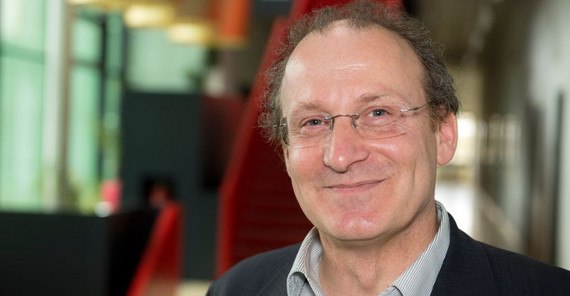A deadly 8.2-magnitude earthquake devastated the Chilean northwest coast in early April 2014. It claimed many lives. The risk of aftershocks was very high. Torsten Dahm is among those who have a scientific interest in such events. Given the dramatic consequences of seismic events, the professor of geophysics faces high expectations by the public, but it is still impossible to predict the location, time, and magnitude of an earthquake, a fact often difficult to convey. “An exact and complete forecast does not work because of the earthquake’s phenomenon,” the scientist explains. You would have to be able to measure a clear, generally valid, and reliable precursor signal that explicitly indicates an earthquake. Obviously, scientists have been looking for precursors for a long time. In fact, such signals have already been measured in some regions but not everywhere. Nowadays we merely have a kind of statistical predictability of the earthquake rate, which is not ubiquitous and does not allow for any deterministic predictions.
Torsten Dahm studied geophysics and seismology. Even as a child he was interested in the natural sciences and was very happy to have the opportunity to study these subjects in Karlsruhe. Earthquakes and geophysics impressed him from the beginning. Using geophysical methods to investigate the earth fascinates him. In his PhD thesis, he developed a procedure to determine earthquake mechanics. In his theoretical work, he analyzed the geometry of ruptures in the earth’s crust and the waves radiated from earthquakes. For his studies, he used data from the Rhine Graben, which is a part of a rift that is still seismically active. People living in the immediate vicinity frequently feel weaker tremors. The scientist was able to collect seismological data back then. He was in charge of surveying seismic stations and analyzing data. “I was able to gain valuable experience for my later research,” Dahm says.
He came to Potsdam to explore new scientific paths, which is why he successfully applied for a joint professorship for geophysics at the University of Potsdam and the Helmholtz-Centre Potsdam – GFZ German Research Centre for Geosciences. This professorship includes the leadership of the “Physics of Earthquakes and Volcanoes” section at the GFZ. Dahm is very interested in this research field and the combination of university and research institution. In Potsdam he can continue working on the issues that interest him “thematically with better possibilities than before.” He had already worked with colleagues at the University of Potsdam on some projects before being jointly appointed to his professorship.
A strong earthquake like in Chile is just one of many possible earthquake processes. Experts studying the physics of earthquakes use a wide spectrum of methods to examine and research such events. The seismic waves following such earthquakes around the world can be recorded in far distance to the epicenter by seismographs. “Equally exciting as teleseismic recordings are strong motion data measured near the epicenter.” Chile, for instance, uses such measuring stations operated by the GFZ. Dahm and his colleagues analyze the recorded data. However, the Potsdam seismologists focus not only on spectacular, strong earthquakes. An important part of their research involves weaker earthquakes, including induced seismicity. In contrast to natural earthquakes, these occur due to man-made changes to nature – e.g. through deep mining or other geotechnical operations. Induced seismicity has been known in mining for centuries. Seismic events have been discussed recently in connection with other activities, like the use of geothermal energy and fracking, and are facing increasing public attention.
Volcanic activity also triggers earthquakes. This is why one of Dahm’s fields of work is the physics of volcanoes, which deals with the basic physical processes of volcanism. Here Dahm and his team are looking for new scientific challenges, because volcanoes are in Germany not often analyzed using geophysical methods. This concerns in particular volcano-magmatic processes in the subsurface.
Even if Dahm is mainly concerned with research, he sees himself as a university lecturer in the literal sense and teaches with passion. Although teaching has to take a backseat to research at the moment, “it is very important to me not to lose contact with the students and to continue teaching on a regular basis.”
The Helmholtz-Centre Potsdam – GFZ
The Helmholtz-Centre Potsdam – GFZ German Research Centre for Geosciences focuses on research of the earth system. Over 460 scientists and nearly 200 PhD students are investigating the history of our planet and the processes that occur on its surface and within its interior. They also study the manifold interactions between the geosphere, cryosphere, hydrosphere, atmosphere, and biosphere.
An essential part of its research activities focuses on the influence of human activities on “System Earth” and the influence of “System Earth” on human society. The geoscientists will use their findings to reduce the risk of natural disasters and sustainably exploit natural resources to ultimately preserve them for mankind. The GFZ develops technological concepts and provides practical knowledge for a sustainable “earth-system management”. The GFZ is affiliated with the University of Potsdam through 23 joint professorships.
www.gfz-potsdam.de
Pearls of Science
The foundation “pearls – Potsdam Research Network” is a unique, interdisciplinary research collaboration between the University of Potsdam and 19 leading extramural research institutions in Brandenburg, each of which is a “pearl” of science. Founded in 2009 on the initiative of the University of Potsdam, “pearls” will use synergies, promote young researchers and attract groundbreaking third-party funded projects. Prof. Torsten Dahm is one of the scientists in this network.
www.pearlsofscience.de
Text: Dr. Barbara Eckardt, Online-Editing: Agnes Bressa, Translation: Susanne Voigt

